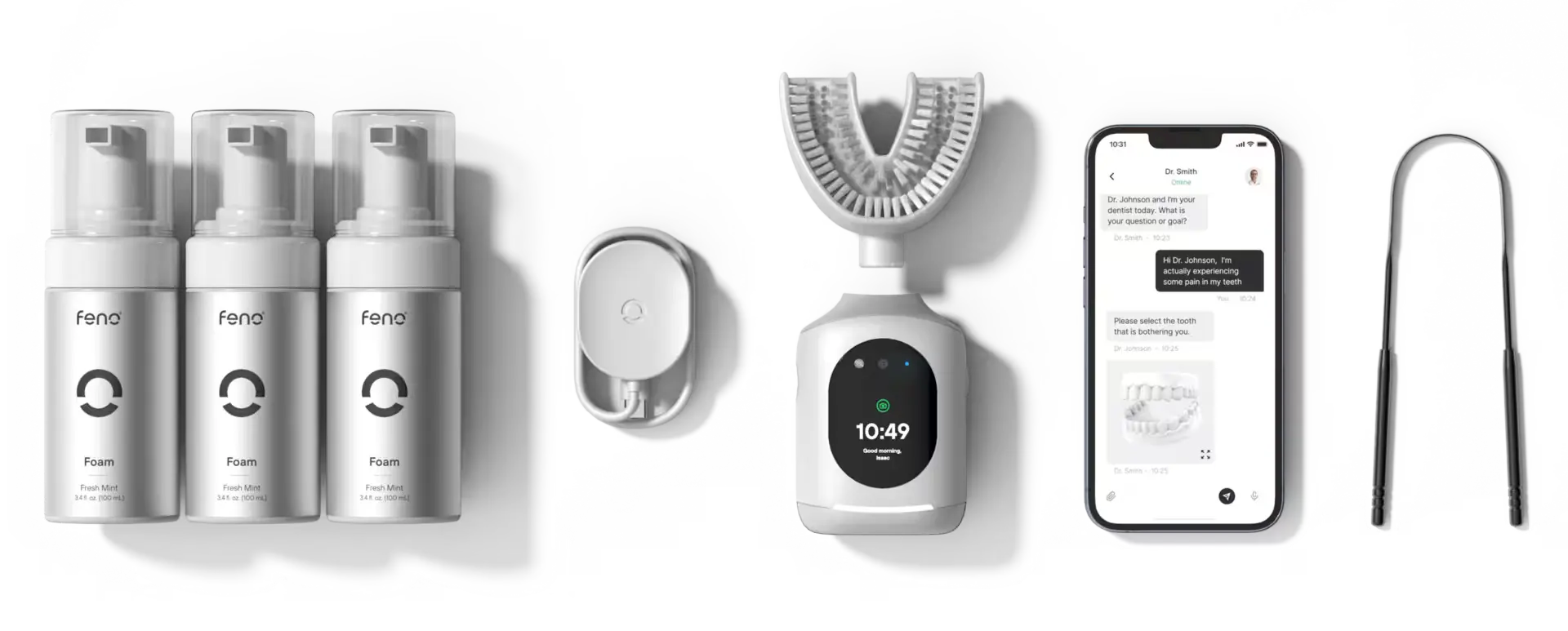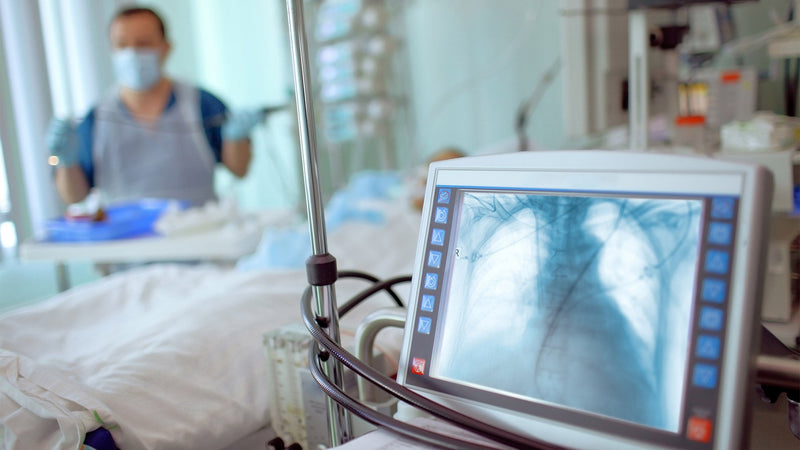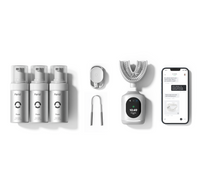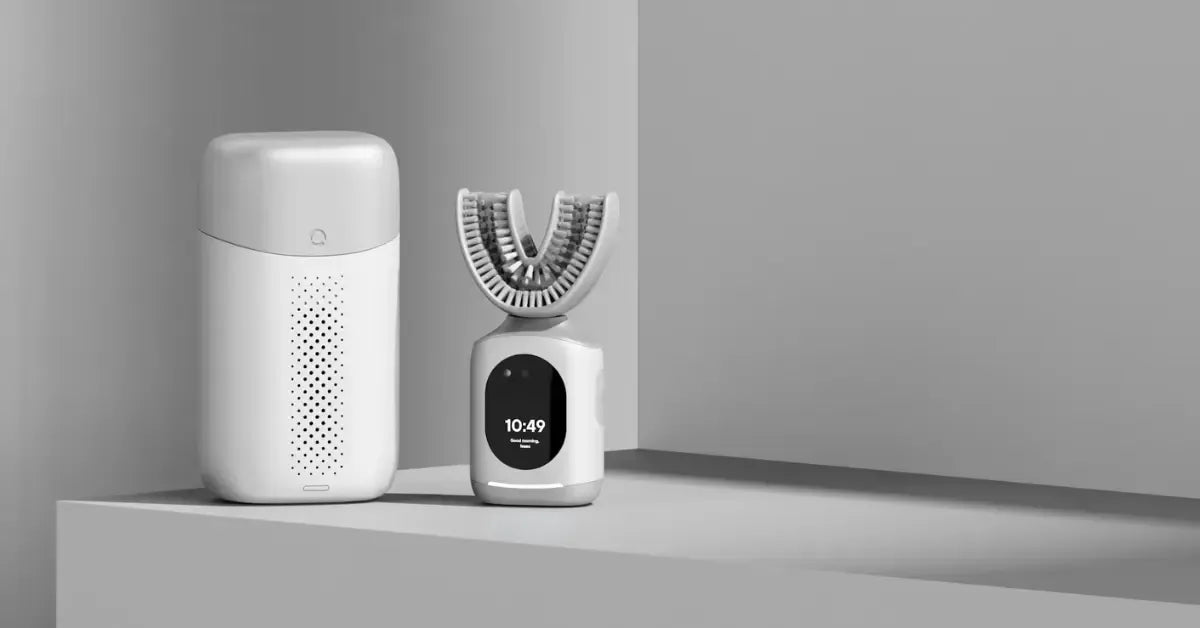
How Advanced Toothbrushes Promote Better Oral Hygiene
Essential Takeaways
- smart toothbrushes represent a significant leap forward in oral hygiene, offering a more effective, personalized, and engaging brushing experience. By leveraging new technologies, they have the potential to revolutionize dental care, not just for individual users but also for professional dental services.
- They offer real-time guidance on brushing pressure, technique, and coverage for consistently effective cleaning.
- Integrated sensors and app connectivity personalize your routine and educate on optimal oral hygiene practices.
- Enhanced plaque removal and controlled pressure help prevent gum disease and tooth decay.
- These devices also bridge daily care with professional oversight by enabling seamless data sharing with dentists.
The journey of toothbrush technology from simple manual brushes to today's advanced toothbrushes is a testament to the incredible strides made in dental care. For centuries, humans have sought better ways to maintain oral hygiene, developing various toothbrush models. However, it wasn't until the advent of electric toothbrushes that we truly began to see a significant shift in effectiveness and efficiency in oral cleaning practices. The latest chapter in this evolution is the emergence of smart toothbrushes, which combine the benefits of electric cleaning with the insights of digital technology. These high-tech devices offer a level of interactivity and personalization that was previously unimaginable, marking a new era in advanced dental care.
The Emergence of Electric Smart Toothbrushes
A Brief History of Toothbrush Innovation
This fascinating journey spans centuries, reflecting humanity's ongoing quest for better oral hygiene. Initially, toothbrushes were rudimentary, made from twigs, feathers, or bone. However, the invention of the nylon-bristled toothbrush in the 1930s marked a significant dental hygiene advancement. The real game-changer, however, came with the introduction of the first electric toothbrush in the 1960s, designed to mimic the motion of manual brushing but with less effort and greater efficiency. This paved the way for the development of electric smart toothbrushes, which emerged at the turn of the 21st century. These devices took the foundational benefits of electric brushing and integrated them with digital technology, offering users unprecedented control over their dental hygiene.

Comparisons Between Electric and Manual Toothbrushes
When deciding between advanced electric toothbrushes and traditional manual toothbrushes, it’s important to consider their respective strengths and weaknesses, as well as your own oral health needs, habits, and lifestyle. Electric toothbrushes have gained popularity for their ability to deliver consistent, automated brushing motions that are difficult to replicate manually. This consistency can lead to more effective plaque removal and improved gum health, especially for individuals who struggle with proper brushing technique or have limited manual dexterity, such as children, seniors, or those with physical impairments. Many electric models also offer built-in timers, pressure sensors, and multiple brushing modes, which help users brush for the dentist-recommended two minutes, avoid excessive force that could damage gums, and customize their brushing experience for sensitive teeth or gum care. These features make electric toothbrushes particularly useful for those seeking enhanced guidance and motivation to maintain optimal oral hygiene.
However, electric toothbrushes are not without drawbacks. The most notable disadvantage is their higher upfront cost, with many models ranging from $50 to $200 or more, in addition to ongoing expenses for replacement brush heads and, in some cases, battery or charging maintenance. Electric toothbrushes also require access to power for charging and may be less convenient for travel, especially in situations where charging is not readily available. Mechanical issues can arise over time, potentially impacting the effectiveness and lifespan of the device. Despite these challenges, many users find the investment worthwhile for the potential oral health benefits, particularly if they are at greater risk for gum disease or have difficulty maintaining effective brushing habits with a manual brush.
In contrast, manual toothbrushes are valued for their simplicity, affordability, and universal accessibility. They require no batteries or charging, making them highly portable and convenient for use anywhere, whether at home, work, or while traveling. Manual toothbrushes are easy to replace, widely available in various designs and bristle types, and cost only a fraction of what electric models do. Manual toothbrushes can be just as effective as electric ones in maintaining oral health for individuals who are diligent with their oral care routine and have excellent brushing technique. However, their effectiveness is highly dependent on the user’s technique, brushing duration, and consistency. Without proper guidance, it’s easy to apply too much or too little pressure, miss hard-to-reach areas, or cut brushing sessions short. Assess your individual oral health needs: people with orthodontic appliances, dental implants, or a history of gum disease may benefit from the enhanced cleaning capabilities and specialized modes of electric toothbrushes. Those with limited dexterity or mobility issues may also find electric models easier to use, as the automated brushing motion requires less effort and skill. On the other hand, if you travel frequently, prefer a low-maintenance routine, or need a budget-friendly option, a manual toothbrush may be more practical. It’s also important to consider your brushing habits. If you tend to rush through brushing or struggle to maintain consistency, the built-in timers and feedback features of electric toothbrushes can help establish better routines.
The best choice depends on your personal preferences, oral health goals, and daily routine. Consulting with a dental professional can provide valuable insights tailored to your specific circumstances, ensuring that the toothbrush you select supports effective, lifelong oral hygiene. Both electric and manual toothbrushes can be effective when used correctly, but the features, convenience, and guidance offered by advanced electric models make them a compelling option for many people seeking to optimize their oral care.
The Advantages of Using Smart Toothbrushes
Optimal Brushing Pressure and Its Importance
One of the critical benefits of smart toothbrushes lies in their ability to regulate brushing pressure, ensuring it's optimal for removing plaque without damaging the gums. Excessive force during brushing can lead to gum recession, sensitivity, and even damage to tooth enamel. This feature protects oral health and educates users on the importance of gentle brushing, contributing significantly to the benefits of electric toothbrushes in promoting long-term dental health.
The Role of Sensors in Effective Cleaning
Sensors play a pivotal role in elevating the effectiveness of dental hygiene practices by enforcing the dentist-recommended two-minute brushing guideline and promoting equitable attention to all mouth sections, thus ensuring a thorough clean. By integrating timing mechanisms and sensing capabilities, modern dental care tools not only facilitate a methodical approach to oral hygiene but also furnish users with valuable real-time feedback on their brushing habits. This feedback can highlight areas for improvement, encouraging adjustments to techniques that may otherwise overlook crucial areas. The synergy of timing and sensory technology within dental care devices represents a significant leap forward, transforming routine brushing into a data-informed practice that optimizes oral health maintenance.
Achieving Even Coverage and Thorough Cleaning
The paramount goal of maintaining oral hygiene is ensuring that every part of the mouth receives adequate attention, a feat that smart toothbrushes excel at facilitating. Here's a closer look at how these can transform your daily brushing routine:
-
Personalized Cleaning: A smart toothbrush adapts to the unique contours of your mouth, ensuring that every tooth and hard-to-reach area receives attention. This personalization extends to dental care needs, with settings that adjust for sensitivity, gum health, or whitening requirements. By catering to individual preferences and needs, they ensure a more effective and comfortable brushing experience.
-
Feedback in Real Time: One of the most beneficial features is their ability to provide immediate feedback on your brushing technique. Through app connectivity, the toothbrush can alert you if you're applying too much pressure, missing areas, or not brushing long enough. This real-time guidance helps correct bad habits on the spot, ensuring a more optimal cleaning every time.
-
Educational Benefits: Beyond just cleaning, they offer educational advantages. Through their apps, users can access a wealth of information on oral health, including tips for better brushing, the importance of flossing, and the latest in dental care research. This educational content empowers users to take a more proactive approach to their oral health, ensuring they are equipped with the knowledge to achieve and maintain a healthy mouth.
By incorporating these features into your daily oral care routine, a smart toothbrush can significantly enhance the effectiveness of your brushing, leading to healthier teeth and gums. The combination of personalized cleaning, real-time feedback, progress tracking, and educational benefits makes them a powerful tool for achieving even coverage and thorough cleaning, laying the foundation for comprehensive oral health.

Top Smart Toothbrushes with Apps
Guidance for Selecting and Using Toothbrushes
Choosing the right toothbrush is a fundamental step in establishing effective oral hygiene, as the ideal brush will align with your unique dental needs and daily routine. When selecting a toothbrush, consider factors such as bristle softness, brush head size, handle design, and compatibility with your oral health status. For those with orthodontic appliances, dental implants, or limited dexterity, electric toothbrushes with compact, oscillating, or sonic heads may provide superior cleaning and ease of use. Manual toothbrushes remain a practical and affordable option, but they require more attention to proper technique to be effective.
Beyond selection, mastering effective brushing techniques is essential for optimal oral health. Regardless of the toothbrush type, position the brush at a 45-degree angle to the gum line and use gentle, circular motions to clean all tooth surfaces. Avoid aggressive back-and-forth scrubbing, as this can wear down enamel and irritate gums. Divide your mouth into quadrants and spend at least 30 seconds on each, ensuring you brush for a total of two minutes twice daily. Pay special attention to the gum line, the backs of teeth, and the chewing surfaces, as these areas are prone to plaque buildup. For electric toothbrush users, let the brush do most of the work. Simply guide the head slowly along each tooth, pausing briefly before moving to the next area. Built-in timers and pressure sensors, common in advanced models, can help maintain the correct duration and pressure, further improving technique and preventing overbrushing.
Equally important is the regular replacement of brush heads. Over time, bristles become frayed and less effective at cleaning, potentially harboring bacteria that compromise oral health. Dental professionals generally recommend replacing your toothbrush or brush head every three months, or sooner if the bristles appear worn or after recovering from an illness. You can significantly enhance your daily oral care and support long-term dental health by choosing a toothbrush tailored to your needs, practicing proper brushing techniques, and adhering to a consistent replacement schedule.
How Apps Enhance the Brushing Experience
Identifying the best smart toothbrush with app integration is key. As emphasized before, these apps serve as a digital bridge, connecting users with a wealth of data about their oral hygiene habits. They offer visual feedback on missed spots, track progress over time, and even gamify the brushing experience to encourage consistent and proper technique. This level of engagement is particularly effective in promoting regular use and adherence to recommended oral care practices, making the mundane task of brushing teeth more appealing and rewarding.
Technological Features
Certain features emerge as particularly advantageous for users seeking to enhance their oral hygiene routine. Essential among these is the app's capability to provide detailed tracking of brushing habits, containing aspects such as duration, frequency, and overall coverage, which are critical for assessing the effectiveness of one's dental care regimen. These features facilitate easy access to the app's functionalities, enabling users to effortlessly incorporate the insights and recommendations provided into their daily oral hygiene practices, thereby maximizing the health benefits and optimizing their dental care routine.
User Experience and Accessibility
Advanced toothbrushes are designed with user-friendliness and accessibility in mind, making them suitable for a wide range of users, including children, seniors, and individuals with special needs or sensitive gums. Many models feature ergonomic handles and intuitive controls, ensuring ease of use even for those with limited dexterity or mobility challenges. Customizable brushing modes and soft bristle options provide a gentle yet effective cleaning experience for users with sensitive gums. Built-in pressure sensors help prevent overbrushing, further safeguarding delicate gum tissue. Mechanical reliability is another important aspect. High-quality advanced toothbrushes are built to withstand daily use, offering consistent performance and long battery life.
Cost-Benefit Considerations
The comparison between the cost of advanced toothbrushes and their potential health benefits helps users assess the value of investing in new oral care technologies. When considering the purchase of an advanced toothbrush, it’s important to weigh the upfront cost against the potential long-term health benefits. Innovative and high-tech electric toothbrushes typically range from $50 to $200 or more, making them a significant investment compared to manual brushes. Advanced toothbrushes may provide substantial savings over time by reducing the risk of gum disease, tooth decay, and the need for costly dental treatments. For many users, the value lies in preventing expensive dental procedures and promoting lifelong oral health, making the higher initial cost a worthwhile consideration for both individuals and families.
Benefits of Electric Toothbrushes Over Manual Brushes
Superior Plaque Removal Capabilities
Electric toothbrushes are celebrated for their advanced design and technology, which significantly enhance plaque removal compared to manual brushing. Their effectiveness lies in several key features that ensure a cleaner, healthier mouth. Here's a look at what sets them apart:
-
Oscillating-Rotating Technology: This innovative movement is designed to clean each tooth with precision. The brush head oscillates and rotates in a way that manual toothbrushes simply can't replicate, allowing for deep cleaning of every surface of the tooth. This targeted approach is highly effective in removing plaque, even from hard-to-reach areas, ensuring a thorough clean every time.
-
Sonic Technology: Sonic electric toothbrushes utilize high-speed vibrations to produce microbubbles that penetrate deep into interdental spaces and along the gum line. This action effectively dislodges plaque and debris from areas that traditional brushing might miss.
-
Built-in Timers: Consistency is key in oral hygiene, and high-tech toothbrushes often feature built-in timers to ensure users brush for the dentist-recommended two minutes. This helps promote a consistent and comprehensive cleaning routine. Adding to the total efficacy of brushing is the timer function, which is a straightforward yet powerful technique for developing ideal brushing habits.
These features collectively enhance the brushing experience, making them vital tools for anyone looking to maintain optimal oral hygiene. Their ability to effectively remove plaque is a cornerstone of their popularity and a primary reason why many dental professionals recommend them over manual brushes.

Impact on Gum and Gingival Health
The best smart electric toothbrushes have transformed the way we approach gum health, offering tangible benefits in the prevention and management of gingivitis and the promotion of healthier gums over time. hort-term and long-term reductions in gingivitis compared to those using manual brushes. A key factor in this improvement is the ability of advanced toothbrushes to help users maintain optimal brushing pressure. Excessive force during brushing is a common cause of gum recession and irritation, yet it often goes unnoticed with manual brushing. Many electric toothbrushes now feature built-in pressure sensors that alert users when they are brushing too hard, prompting gentler techniques that protect delicate gum tissue. This prevents damage and encourages the adoption of healthier brushing habits, reducing the risk of gum recession and sensitivity over time. Additionally, advanced toothbrushes often include specialized modes for gum care or massage, which use gentle pulsations or vibrations to stimulate blood flow in the gums. Increased circulation supports the healing and regeneration of gum tissue, further enhancing oral health outcomes.
Ergonomic Design and Long Battery Life
Designed for comfort and ease of use, these brushes encourage proper brushing techniques and can be particularly beneficial for individuals with mobility issues or conditions like arthritis. Additionally, the long battery life ensures that these devices are ready for use without the constant need for recharging, making them convenient for both home and travel.
Potential Considerations
While advanced toothbrushes offer a range of benefits, there are also important drawbacks to consider before making the switch. One of the most notable disadvantages is the higher upfront cost compared to manual toothbrushes, with additional ongoing expenses for replacement brush heads and, in some cases, battery or charging maintenance. Maintenance requirements can be more involved, as users must regularly clean the device, replace brush heads, and ensure the battery remains charged or functional. Furthermore, mechanical issues such as battery degradation, malfunctioning motors, or connectivity problems with smart features may arise over time, potentially impacting the toothbrush’s effectiveness and lifespan. These factors can be inconvenient, especially for those seeking a low-maintenance oral care routine. While many users find the investment worthwhile for the potential oral health benefits, weighing these considerations and determining whether the added complexity and cost align with personal preferences and needs is essential.
The Future of Dental Care with Smart Toothbrushes
Anticipating Technological Advancements in Oral Hygiene
The future of oral hygiene looks bright, with technological advancements expected to bring even more sophisticated features to smart toothbrushes. Innovations may include more advanced sensors for detecting early signs of dental issues such as cavities and gum disease, and even the ability to analyze saliva for health markers. The potential for these tools to not just clean but also diagnose and predict oral health issues could revolutionize dental care, making preventive strategies more effective than ever.
The Role of AI and Machine Learning in Dental Care
Artificial Intelligence (AI) and Machine Learning are set to play a crucial role in the evolution of smart toothbrushes. By harnessing these technologies, toothbrushes will become even smarter, learning from individual brushing habits to provide highly personalized guidance. This could lead to AI-driven recommendations for brushing techniques, timing, and even nutrition advice tailored to support oral health. The ability to adapt and respond to the unique needs of each user will mark a new era in personalized dental care.
Professional Dental Care
The data collected by these devices can be shared with dentists, providing a wealth of information that can inform treatment plans and preventive care strategies. This could lead to a more collaborative approach to dental health, where patients and professionals work together more closely, leveraging technology to achieve the best outcomes. The potential for smart toothbrushes to bridge the gap between daily oral care and professional dental services is immense, promising a future where dental health is more closely monitored, understood, and managed.

The journey towards better dental health, facilitated by technological advancements, is a testament to the power of innovation in enhancing our quality of life. As we embrace these changes, it's essential to remain open to new possibilities and advancements that can further improve our oral hygiene practices. The role of smart toothbrushes in this journey is crucial, offering a glimpse into a future where dental care is seamlessly integrated into our daily lives, making oral health maintenance an effortless part of our routine. The ongoing evolution of dental care technology is not just about smarter toothbrushes. It's about creating a healthier future for everyone, with oral hygiene at the heart of overall well-being. Upgrade your oral care routine with smarter brushing technology, and discover advanced toothbrushes at Feno.co.
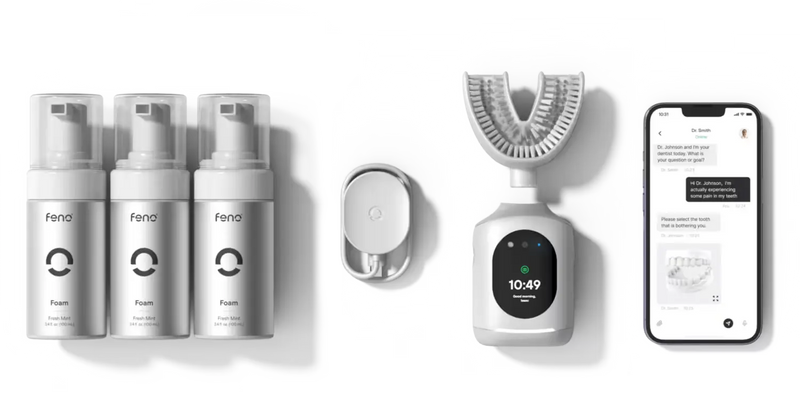
Feno Founders Edition Bundle
Advanced Oral Health in 20 Seconds with the Feno Smartbrush™
Get Yours Now!